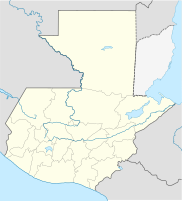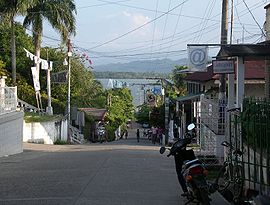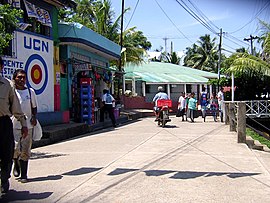Livingston (Izabal)
| Livingston | ||
|---|---|---|
|
Coordinates: 15 ° 50 ′ N , 88 ° 45 ′ W Livingston on the map of Guatemala
|
||
| Basic data | ||
| Country | Guatemala | |
| Department | Izabal | |
| City foundation | 1831 | |
| Residents | 48,588 (2002) | |
| Detailed data | ||
| surface | 1940 km 2 | |
| Population density | 25 people / km 2 | |
| height | 3 m | |
| Waters | Bahía de Amatique, Río Dulce | |
| Post Code | 18002 | |
| Time zone | UTC −6 | |
| City patron | Virgen del Rosario | |
| Website | ||
| Street in Livingston | ||
| Street festival of the Garifunas in Livingston | ||
| Everyday life in Livingston | ||
Livingston is a small town on the Caribbean coast of Guatemala . It is the administrative seat of the large municipality of the same name ( Municipio ) in the department of Izabal .
geography
Livingston is on the north side of the mouth of the Río Dulce in the Gulf of Honduras . The place with its 16,000 inhabitants can only be reached by sea. Puerto Barrios , the capital of the department Izabal, is about 20 km southeast in the Bahía de Amatique . About 30 km north of Livingston is Punta Gorda , the southernmost port city of Belize . The Río Dulce connects the 30 km inland Río Dulce and Lake Izabal with the Caribbean. There are regular boat connections to Livingston from these three locations.
The 1,940 km² municipality covers the area between the Río Sarstún ( Sarstoon River ) in the north, which also forms the border with Belize, the Sierra de Santa Cruz and Lake Izabal in the west and south-west, the Montañas del Mico in the south and the Caribbean coast in the northeast. In the middle is the Río Dulce National Park with the Golfete and the Biotopo Chacón Machaca . The municipality is almost completely covered by tropical rainforest . Politically and administratively , Livingston borders in the north on Belize ( Toledo District ), in the northwest on the Department Petén ( San Luis ), in the southwest on El Estor , in the south on Morales and in the east on Puerto Barrios.
population
Livingston is known for its unusual mix of different ethnic groups and cultures such as Garifuna , Kekchí and Ladino . The city is shaped by the Garifuna, the only dark-skinned Afro - Caribbean ethnic group in Guatemala. The municipality has a total of more than 50,000 inhabitants. Of these, 48% are Kekchí, 42% Ladinos, 9% Garífuna and 1% others.
history
The estuary of the Río Dulce was of particular strategic and economic importance during and before the colonial era. Both the Río Dulce and Lake Izabal offered sheltered anchorages for shipping . Larger warehouses were set up on the shores of the lake, which were also easily accessible from the rest of the country. In the pre-colonial era of the Late Classic , the Nito trading center was built a little west of today's Livingston . The Spaniards who invaded in 1524 founded the town of San Gil de Buena Vista on the south side of the estuary, but it was soon relocated. In the centuries that followed, the estuary degenerated into a haven of anarchy and piracy .
In 1802 a brigantine under the command of Marcos Sánchez Díaz reached the estuary of the Río Dulce with a number of Afro-Caribbean refugees from Roatán . Some of these people settled there and founded a place called La Buga (Garifuna for "Boca", meaning "estuary") in 1806 . Another part moved on (at least temporarily) to Punta Gorda in what is now Belize. Some of the long-established pirate families and some newcomers withdrew to the surrounding area and built new houses there; soon others joined them, and the villages that emerged were named after the first families there, including Tatín and Baltimore. The further influx of Afro-Caribs to Livingston prompted the authorities in 1831 to formally found a community, which was named Livingston in 1837. The name comes from the US lawyer and politician Edward Livingston , who wrote the Livingston Codes . These served as the basis for the laws of the liberal government of the Central American Confederation in the early 19th century . The place developed relatively quickly into the most important seaport on the Caribbean coast of Guatemala. In the 19th century the administrative seat of the department of Izabal was moved from the place of the same name on the south bank of the lake to Livingston and back several times. With the establishment of the port city of Puerto Barrios, which can also be reached by land, in 1895, Livingston's decline began, which intensified after the inauguration of the railway line from Guatemala City to Puerto Barrios in 1908. Still, Livingston remained the capital of Izabal until 1920, when it had to cede its political position to Puerto Barrios. In the years that followed, many Garifunas emigrated to the USA , with Livingston losing much of its original cultural character. In the 1960s and 1970s, Livingston was a travel destination and gathering place for the North American hippie movement . In the recent past Livingston has developed into a tourist attraction because of its cultural uniqueness, its scenic charm and the low traffic.
economy
The most important industries are fishing and the cultivation of bananas , cassava , corn and beans . Only a few business people benefit from tourism . The timber industry and the manufacture of basketry and objects from coconut nuts play a subordinate role . The majority of the population lives in subsistence farming or doing odd jobs. An important employer in the region is traditionally the port of Puerto Barrios and that of Santo Tomás de Castilla. The tendency to emigrate to the USA continues.
Attractions
The main attractions in Livingston include the festivals in honor of the city's patroness Virgen del Rosario (October 7th), the Garífuna festival on November 25th and 26th, and the great Christmas and New Year's Eve festival between December 24th and January 1st . The rest of the municipality is one of the most important tourist destinations in Guatemala, mainly because of the Río Dulce and Lake Izabal.




